The Influence of Pore Size on the Photocatalytic and SERS Performance of Nanoporous Au–Ag Shells
Abstract
1. Introduction
2. Results and Discussions
2.1. Microstructure and Composition Analysis of NPASs
2.2. UV–Vis Spectroscopy Analysis and LSPR Properties
2.3. SERS Enhancement Effect and Catalytic Activity Analysis
2.4. The Influence of Photothermal Effects on Catalytic Kinetics
3. Materials and Methods
3.1. Materials
3.2. Synthesis of Ag Nanoparticles (NPs)
3.3. Synthesis of Au–Ag Alloy Nanoshells (ANSs)
3.4. Preparation of SERS-Active NPAS Substrates
3.5. Microstructural Characterization and Raman Spectrum
4. Conclusions
Author Contributions
Funding
Institutional Review Board Statement
Informed Consent Statement
Data Availability Statement
Acknowledgments
Conflicts of Interest
References
- Zhong, W.; Zhang, J.; Zhu, C.; Tang, H.; Liu, X.; Qiao, Z.; Liu, Y. A temperature-sensitive and fluorescent Tr-CDs/AuNPs based catalyst for efficient, monitorable, and recyclable catalytic reactions. Nanoscale 2025, 17, 2644–2657. [Google Scholar] [CrossRef] [PubMed]
- Han, Q.; Zhang, C.; Gao, W.; Han, Z.; Liu, T.; Li, C.; Wang, Z.; He, E.; Zheng, H. Ag-Au alloy nanoparticles: Synthesis and in situ monitoring SERS of plasmonic catalysis. Sens. Actuators B Chem. 2016, 231, 609–614. [Google Scholar] [CrossRef]
- Li, M.; Liu, X.; Sun, C.; Cao, X.; Zhang, Y.; Hou, L.; Yang, H.; Xu, C. Ultra-Sensitive Simultaneous Detection of Dopamine and Acetaminophen over Hollow Porous AuAg Alloy Nanospheres. Nanomaterials 2024, 14, 1131. [Google Scholar] [CrossRef] [PubMed]
- Kadja, G.T.M.; Ilmi, M.M.; Azhari, N.J.; Khalil, M.; Fajar, A.T.N.; Subagjo; Makertihartha, I.G.B.N.; Gunawan, M.L.; Rasrendra, C.B.; Wenten, I.G. Recent advances on the nanoporous catalysts for the generation of renewable fuels. J. Mater. Res. Technol. 2022, 17, 3277–3336. [Google Scholar]
- Wang, J.; Li, Z.; Li, R.; Wang, H.; Wu, Y.; Liu, X.; Lu, Z. Nanoporous Metals Based on Metallic Glasses: Synthesis, Structure and Functional Applications. Acta Metall. Sin. Engl. Lett. 2023, 36, 1573–1602. [Google Scholar] [CrossRef]
- Barbillon, G. Latest Advances in Nanoplasmonics and Use of New Tools for Plasmonic Characterization. Photonics 2022, 9, 112. [Google Scholar] [CrossRef]
- Zhang, Z.; Zhang, C.; Zheng, H.; Xu, H. Plasmon-Driven Catalysis on Molecules and Nanomaterials. Acc. Chem. Res. 2019, 52, 2506–2515. [Google Scholar] [CrossRef]
- Chen, T.; Hu, J.; Mou, J.; Wang, K.; Shen, F.; Wu, S.; Zhao, P.; Shi, J. High oxidation state on porous Ga-Ag9In4 catalyst enhance CO2 electroreduction to CO. J. Alloys Compd. 2024, 1007, 176439. [Google Scholar] [CrossRef]
- Liz-Marzán, L.M.; Willets, K.A.; Chen, X. Fifty Years of Surface-Enhanced Spectroscopy. ACS Nano 2024, 18, 5995–5997. [Google Scholar] [CrossRef]
- Jing, Z.; Zhang, L.; Xu, X.; Zhu, S.; Zeng, H. Carbon-Assistant Nanoporous Gold for Surface-Enhanced Raman Scattering. Nanomaterials 2022, 12, 1455. [Google Scholar] [CrossRef]
- Yuan, C.; Zhang, D.; Xu, P.; Gan, Y. Nanoporous Silver Films for Surface-Enhanced Raman Scattering-Based Sensing. ACS Appl. Nano Mater. 2024, 7, 16141–16153. [Google Scholar] [CrossRef]
- Huang, Z.; Peng, J.; Xu, L.; Liu, P. Development and Application of Surface-Enhanced Raman Scattering (SERS). Nanomaterials 2024, 14, 1417. [Google Scholar] [CrossRef] [PubMed]
- Chen, Q.; Zhao, L.; Liu, H.; Ding, Q.; Jia, C.; Liao, S.; Cheng, N.; Yue, M.; Yang, S. Nanoporous silver nanorods as surface-enhanced Raman scattering substrates. Biosens. Bioelectron. 2022, 202, 114004. [Google Scholar] [CrossRef]
- van der Zalm, J.; Chen, S.; Huang, W.; Chen, A. Review—Recent Advances in the Development of Nanoporous Au for Sensing Applications. J. Electrochem. Soc. 2020, 167, 037532. [Google Scholar] [CrossRef]
- Yu, X.; Adronov, A. Facile Preparation of Carbon Nanotube-Based Skin-Like Pressure Sensors. Small 2024, 2408795. [Google Scholar] [CrossRef]
- Zhang, Q.; Deng, T.-S.; Dou, Y.-Q.; Wei, M.-Z.; Li, S.; Liu, J.; Cheng, Z. Trimetallic Nanostructures of Silver–Platinum Alloy Shells on Gold Nanorods for Plasmon-Mediated Photocatalysis. ACS Appl. Nano Mater. 2022, 5, 17048–17058. [Google Scholar] [CrossRef]
- Liu, W.; Yan, Z.; Zhang, W.; Wen, K.; Sun, B.; Hu, X.; Qin, Y. Facile Preparation of Au–Ag Composite Nanostructure for High-Sensitive and Uniform Surface-Enhanced Raman Spectroscopy. Photonics 2023, 10, 354. [Google Scholar] [CrossRef]
- Zhu, J.; Zhang, Q.; Wang, C.; Feng, Y.; Qi, G.; Zhang, Y.; Lian, K.; Luo, J.; Liu, X. Improved performances toward electrochemical carbon dioxide and oxygen reductions by iron-doped stannum nanoparticles. Nanoscale 2025, 17, 2709–2717. [Google Scholar] [CrossRef]
- Xie, X.; Briega-Martos, V.; Alemany, P.; Mohandas Sandhya, A.L.; Skála, T.; Rodríguez, M.G.; Nováková, J.; Dopita, M.; Vorochta, M.; Bruix, A.; et al. Balancing Activity and Stability through Compositional Engineering of Ternary PtNi–Au Alloy ORR Catalysts. ACS Catal. 2024, 15, 234–245. [Google Scholar] [CrossRef]
- Cui, Y.; Sun, C.; He, Y.; Feng, Z.; Ding, G.; Dai, Q.; Wang, T.; Wang, Z.; Jiang, Q. Boosting Electrocatalytic Nitrate Reduction to Ammonia on a Hierarchical Nanoporous Ag,Ni-Codoped Cu Catalyst via Trimetallic Synergistic and Nanopore Enrichment Effects. Nano Lett. 2025, 25, 837–844. [Google Scholar] [CrossRef]
- Weng, Y.; Li, Q.; Li, K. Cost-Effective RuNi Solid Solutions Prepared by Electrodeposition for Efficient Alkaline Hydrogen Evolution. Small 2025, 21, 2410778. [Google Scholar] [CrossRef]
- Koya, A.N.; Zhu, X.; Ohannesian, N.; Yanik, A.A.; Alabastri, A.; Proietti Zaccaria, R.; Krahne, R.; Shih, W.-C.; Garoli, D. Nanoporous Metals: From Plasmonic Properties to Applications in Enhanced Spectroscopy and Photocatalysis. ACS Nano 2021, 15, 6038–6060. [Google Scholar] [CrossRef] [PubMed]
- Perovic, M.; Tarakina, N.V.; Hofmann, J.P.; Oschatz, M. Influence of Local Environments in Pores of Different Size on the Catalytic Liquid-Phase Oxidation of d-Glucose by Au Nanoparticles Supported on Nanoporous Carbon. ACS Appl. Nano Mater. 2020, 3, 7695–7703. [Google Scholar] [CrossRef]
- Zhang, P.; Wang, C.; Zhang, J.; Hou, R.; Zhang, S.; Liu, K.; Silva, S.R.P.; Zhang, P.; Shao, G. Developing High Energy Density Li-S Batteries via Pore-Structure Regulation of Porous Carbon Based Electrocatalyst. Small 2024, 2410907. [Google Scholar] [CrossRef]
- Liu, G.; Li, K.; Zhang, Y.; Du, J.; Ghafoor, S.; Lu, Y. A facile periodic porous Au nanoparticle array with high-density and built-in hotspots for SERS analysis. Appl. Surf. Sci. 2020, 527, 146807. [Google Scholar] [CrossRef]
- Orhan, O.B.; Polat, N.; Demir, S.; Mert Balci, F.; Balci, S. Light-Induced, Liquid Crystal-Templated Fabrication of Large-Area Pure Nanoporous Gold Films with High-Density Plasmonic Cavities. J. Phys. Chem. C 2024, 128, 20316–20323. [Google Scholar] [CrossRef]
- Fu, J.; Deng, Z.; Detsi, E. Nanoporous Gold Formation by Free Corrosion Dealloying of Gold-Silver Alloys in Nonoxidizing Acids Driven by Catalytic Oxygen Reduction Reaction. JOM 2019, 71, 1581–1589. [Google Scholar] [CrossRef]
- Kubota, J.; Liu, J.; Detsi, E. Rapid Synthesis of Nanoporous Zn Powder by Selective Etching of Al from Micrometer-Sized Zn–Al Powder Particles Produced by Gas Atomization and Its Application in Hydrogen Generation. ACS Appl. Mater. Interfaces 2024, 16, 70469–70476. [Google Scholar] [CrossRef]
- Román-Varela, C.A.M.; Calixto, M.E.; Diliegros-Godines, C.J.; Bustamante, A.; ÁngelContreras-Ruiz, M.; Soucase, B.; Shafi, U. A Rapid Methodology to Obtain Silver Selenide thin Films with Highly Enhanced Thermoelectric Performance. Small 2025, 21, 2408477. [Google Scholar] [CrossRef]
- Im, J.-H.; Han, M.; Hong, J.; Kim, H.; Oh, K.-S.; Choi, T.; Yusoff, A.R.b.M.; Vasilopoulou, M.; Lee, E.; Hwang, C.-C.; et al. Controlled Synthesis of Perovskite Nanocrystals at Room Temperature by Liquid Crystalline Templates. ACS Nano 2025, 19, 1177–1189. [Google Scholar] [CrossRef]
- Srinoi, P.; Marquez, M.; Lee, T.-C.; Lee, T. Hollow Gold-Silver Nanoshells Coated with Ultrathin SiO2 Shells for Plasmon-Enhanced Photocatalytic Applications. Materials 2020, 13, 4967. [Google Scholar] [CrossRef]
- Moreira, M.; Cottancin, E.; Pellarin, M.; Roiban, L.; Masenelli-Varlot, K.; Ugarte, D.; Rodrigues, V.; Hillenkamp, M. Intrinsic Coexistence of Miscibility and Segregation in Gold–Silver Nanoalloys. Small 2024, 21, 2411151. [Google Scholar] [CrossRef] [PubMed]
- Kautsar, D.B.; Le, P.H.; Ando, A.; Tanabe, E.; Cao, K.L.A.; Septiani, E.L.; Hirano, T.; Ogi, T. Enhancing CO oxidation performance by controlling the interconnected pore structure in porous three-way catalyst particles. Nanoscale 2025, 17, 2841–2851. [Google Scholar] [CrossRef] [PubMed]
- Ortolani, M.; Mancini, A.; Budweg, A.; Garoli, D.; Brida, D.; de Angelis, F. Pump-probe spectroscopy study of ultrafast temperature dynamics in nanoporous gold. Phys. Rev. B 2019, 99, 035435. [Google Scholar] [CrossRef]
- Jellicoe, M.; Yang, Y.; Stokes, W.; Simmons, M.; Yang, L.; Foster, S.; Aslam, Z.; Cohen, J.; Rashid, A.; Nelson, A.L.; et al. Continuous Flow Synthesis of Copper Oxide Nanoparticles Enabling Rapid Screening of Synthesis-Structure-Property Relationships. Small 2025, 21, 2403529. [Google Scholar] [CrossRef]
- Takemae, K.; Tomihari, S.; Naitou, T.; Takagi, M.; Shimazaki, T.; Kawawaki, T.; Tachikawa, M.; Negishi, Y. Inclusion of Gold Ion in Tiara-Like Nickel Hexanuclear Nanoclusters. Nanoscale 2025, 17, 3721–3727. [Google Scholar] [CrossRef]
- Schumacher, L.; Hofmann, K.; Hess, C. Elucidating the Reaction Mechanism and Deactivation of CO2-Assisted Propane Oxidative Dehydrogenation over VOx/TiO2 Catalysts: A Multiple Operando Spectroscopic Study. ACS Catal. 2024, 15, 939–955. [Google Scholar] [CrossRef]
- Ge, K.; Huang, Y.; Zhang, H.; Gu, Y. Sensitive, selective and rapid detection of 4,4′-methylenedianiline by surface-enhanced Raman spectroscopy using flower-like gold-silver nanoalloy embedded nickel-cobalt layered double hydroxide composites. Sens. Actuators B Chem. 2022, 361, 131734. [Google Scholar] [CrossRef]
- Gutiérrez, Y.; Alcaraz de la Osa, R.; Ortiz, D.; Saiz, J.; González, F.; Moreno, F. Plasmonics in the Ultraviolet with Aluminum, Gallium, Magnesium and Rhodium. Appl. Sci. 2018, 8, 64. [Google Scholar] [CrossRef]
- Koushki, E.; Doost, H.A. Optical spectra of conjugated gold nano-colloids; Scattering cross section and effects of solvent and polydispersity. Results Chem. 2025, 13, 102024. [Google Scholar] [CrossRef]
- Yang, W.; Wu, K.; Yang, W.; Wang, H.; Lv, X.; Qian, L.; Yu, T.; Li, Z.; Zhou, X.; Okumu Barasa, G.; et al. Nanoporous Au-Ag shell with fast kinetics: Integrating chemical and plasmonic catalysis. Nanotechnology 2017, 28, 425704. [Google Scholar] [CrossRef] [PubMed]
- Hu, M.; Huang, Z.; Liu, R.; Zhou, N.; Tang, H.; Meng, G. SERS spectral evolution of azo-reactions mediated by plasmonic Au@Ag core–shell nanorods. Nanoscale Adv. 2022, 4, 4730–4738. [Google Scholar] [CrossRef] [PubMed]
- Ibrahim, S.; Dworzak, A.; Crespo, D.; Renner, F.U.; Dosche, C.; Oezaslan, M. Nanoporous Copper Ribbons Prepared by Chemical Dealloying of a Melt-Spun ZnCu Alloy. J. Phys. Chem. C 2021, 126, 212–226. [Google Scholar] [CrossRef]
- Liu, Y.; Zhang, Y.; Yu, B.; Tan, F.; Cheng, G.; Zhang, Z. Formation and microstructures of nanoporous gold films with tunable compositions/porosities/sizes through chemical dealloying of dilute solid solution Cu-Au alloys. J. Alloys Compd. 2025, 1010, 178152. [Google Scholar] [CrossRef]
- Mohd Shumiri, M.A.I.; Mohd Najib, A.S.; Putra, A.E.E.; Fadil, N.A. Electrochemical and chemical dealloying of nanoporous anode materials for energy storage applications. Sci. Technol. Adv. Mater. 2025, 26, 2451017. [Google Scholar] [CrossRef]
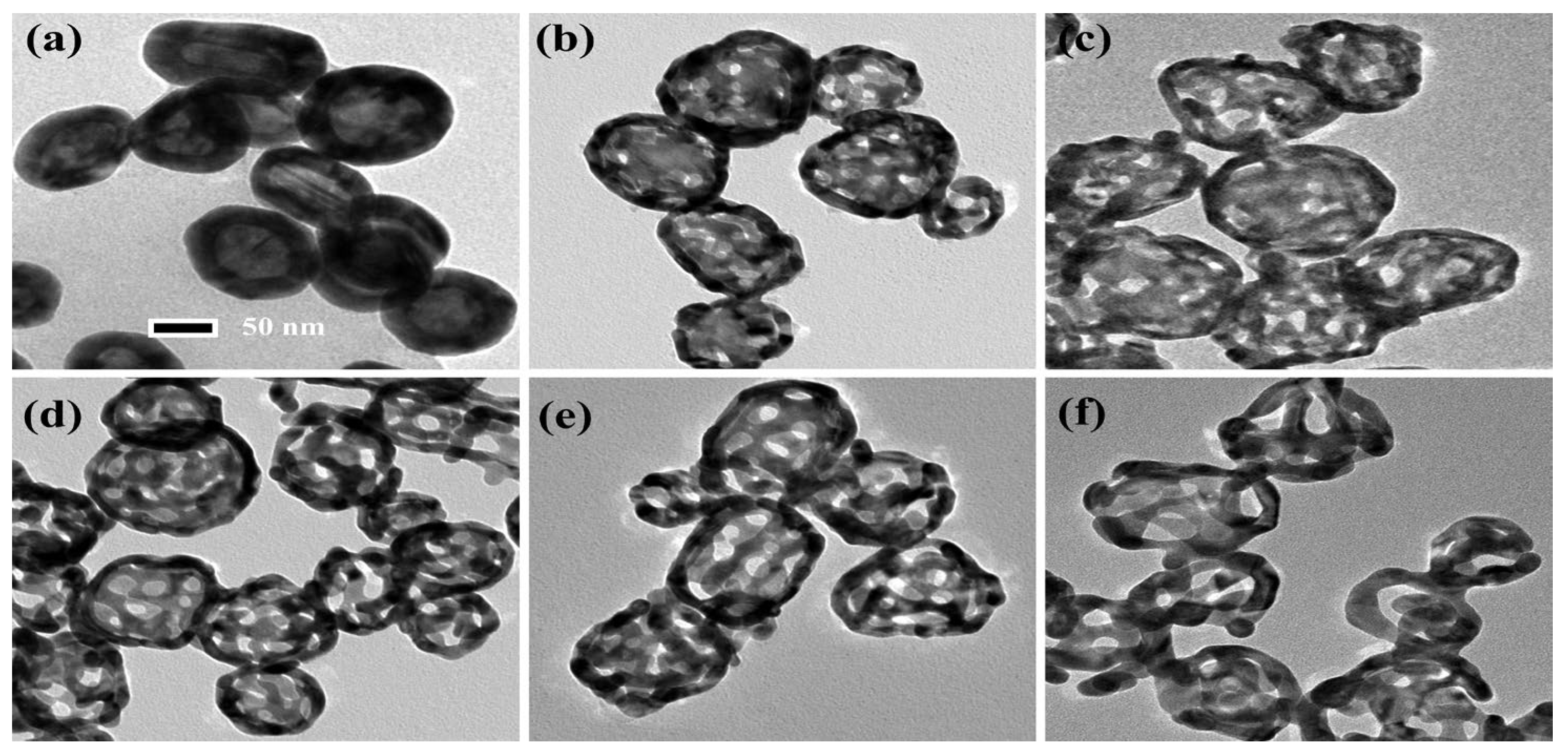
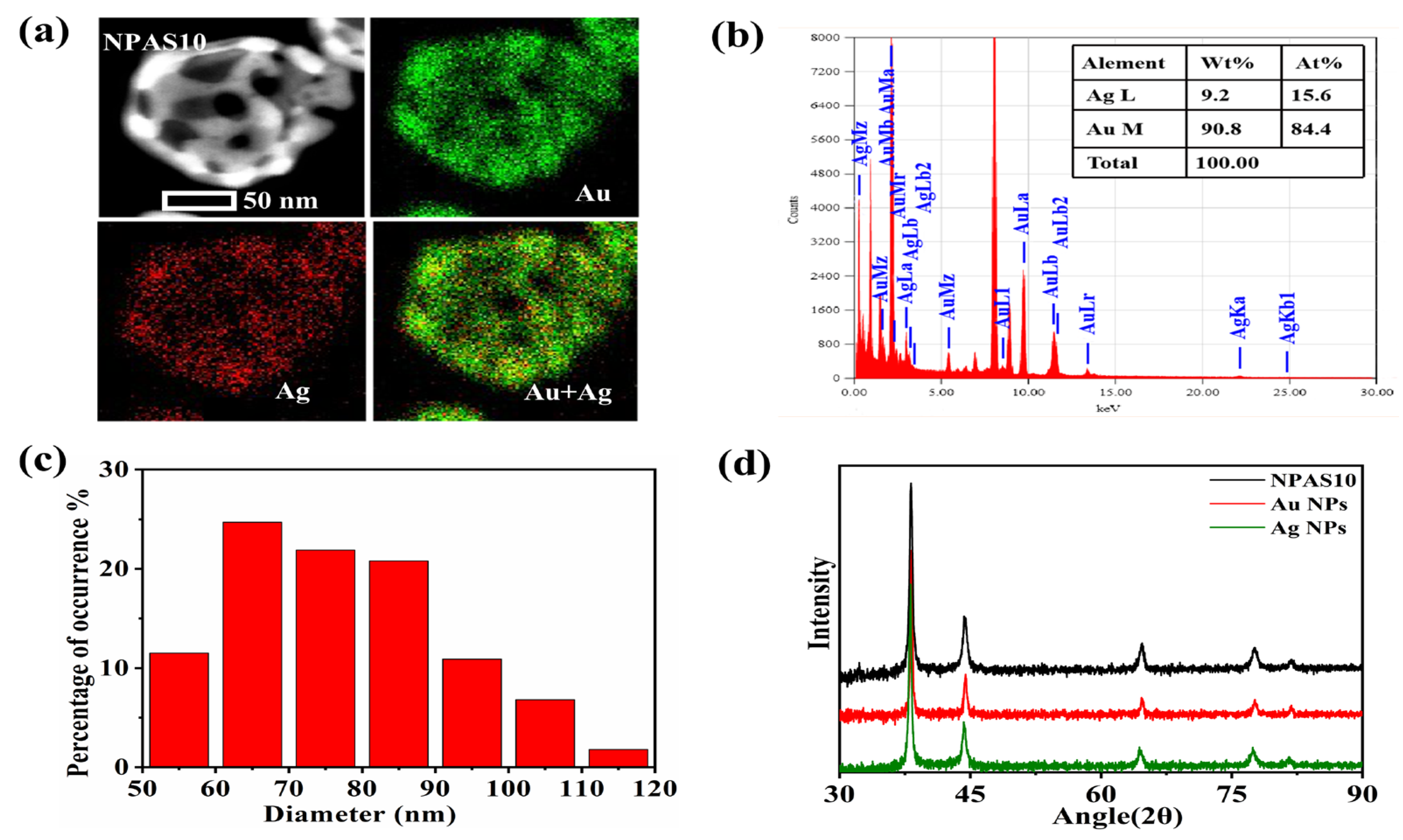
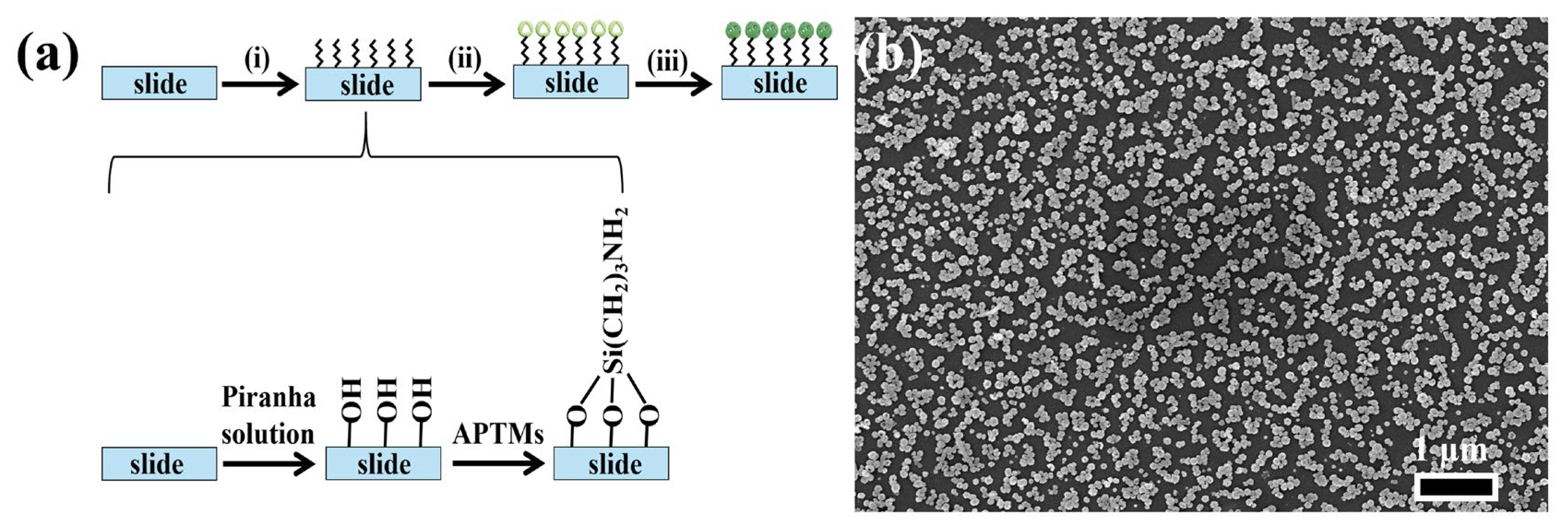



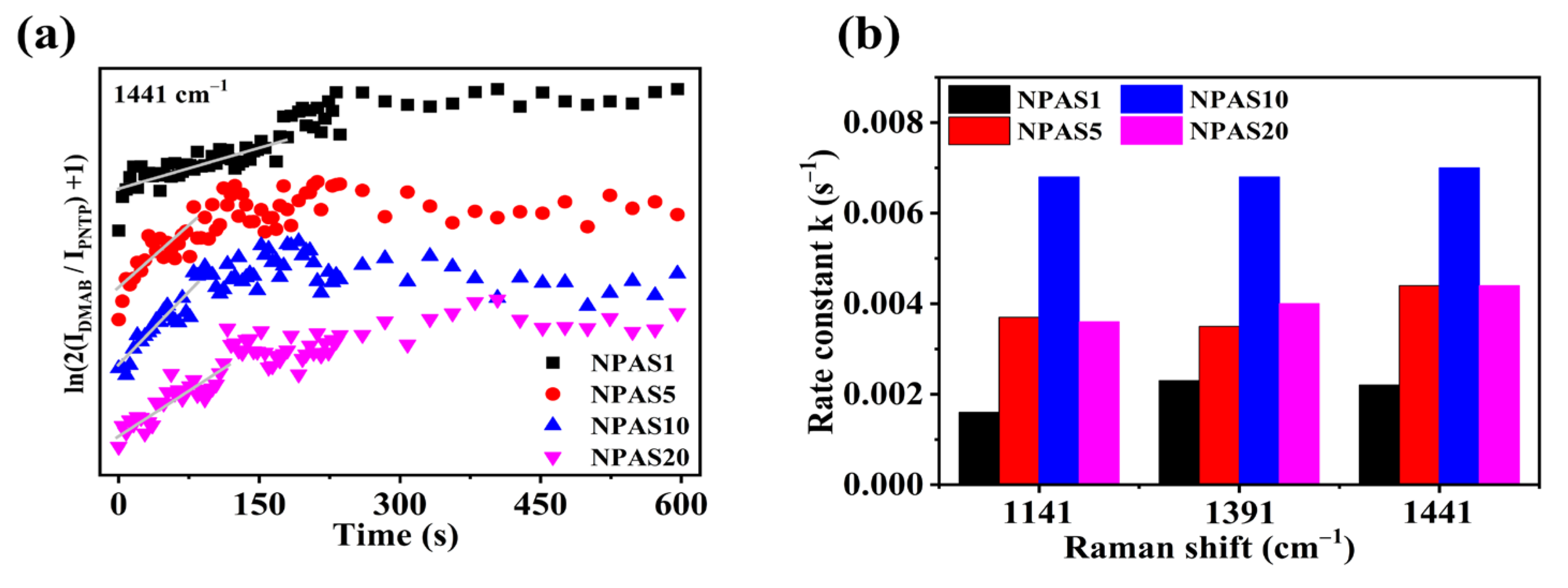
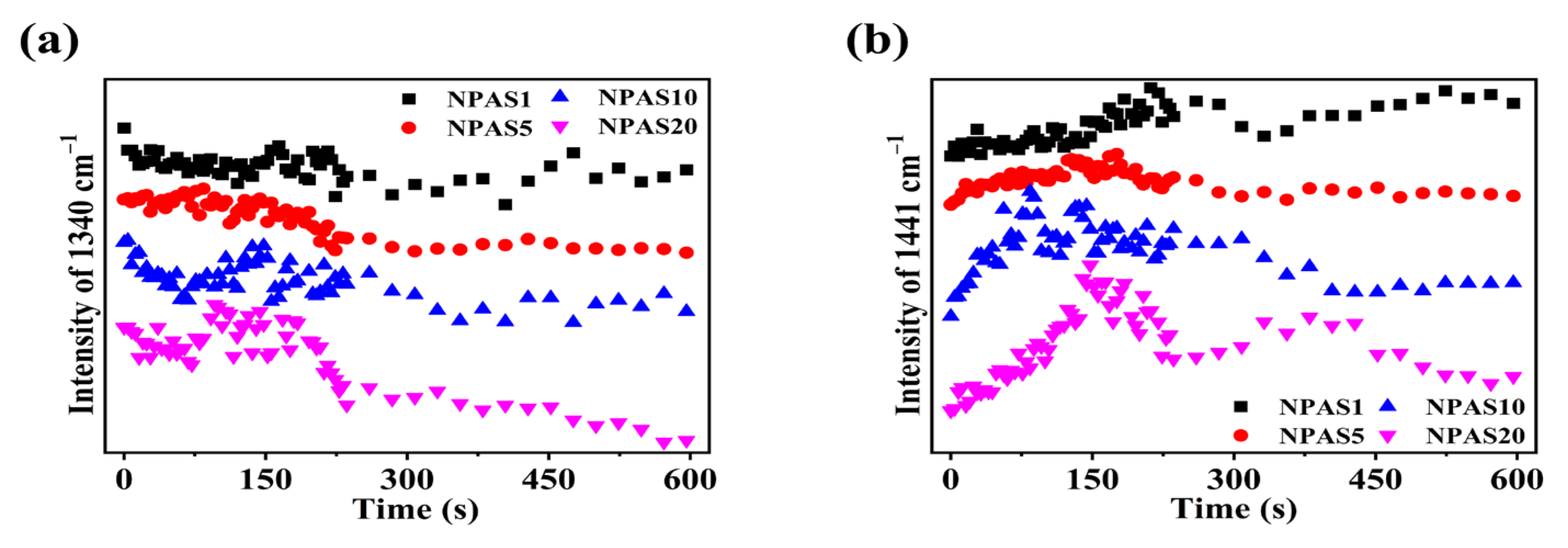
Disclaimer/Publisher’s Note: The statements, opinions and data contained in all publications are solely those of the individual author(s) and contributor(s) and not of MDPI and/or the editor(s). MDPI and/or the editor(s) disclaim responsibility for any injury to people or property resulting from any ideas, methods, instructions or products referred to in the content. |
© 2025 by the authors. Licensee MDPI, Basel, Switzerland. This article is an open access article distributed under the terms and conditions of the Creative Commons Attribution (CC BY) license (https://creativecommons.org/licenses/by/4.0/).
Share and Cite
Yang, W.; Geng, W.; Lu, X.; Qian, L.; Luo, S.; Zheng, R.; Xu, L.; Yang, D. The Influence of Pore Size on the Photocatalytic and SERS Performance of Nanoporous Au–Ag Shells. Molecules 2025, 30, 1475. https://doi.org/10.3390/molecules30071475
Yang W, Geng W, Lu X, Qian L, Luo S, Zheng R, Xu L, Yang D. The Influence of Pore Size on the Photocatalytic and SERS Performance of Nanoporous Au–Ag Shells. Molecules. 2025; 30(7):1475. https://doi.org/10.3390/molecules30071475
Chicago/Turabian StyleYang, Wenpeng, Wenguang Geng, Xiyuan Lu, Lihua Qian, Shijun Luo, Rui Zheng, Lei Xu, and Dapeng Yang. 2025. "The Influence of Pore Size on the Photocatalytic and SERS Performance of Nanoporous Au–Ag Shells" Molecules 30, no. 7: 1475. https://doi.org/10.3390/molecules30071475
APA StyleYang, W., Geng, W., Lu, X., Qian, L., Luo, S., Zheng, R., Xu, L., & Yang, D. (2025). The Influence of Pore Size on the Photocatalytic and SERS Performance of Nanoporous Au–Ag Shells. Molecules, 30(7), 1475. https://doi.org/10.3390/molecules30071475





